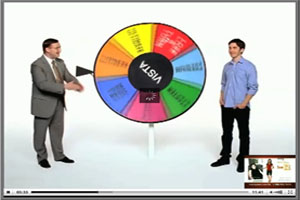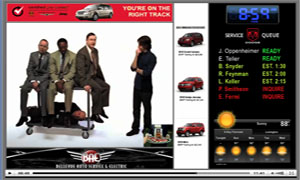Live Ad Replacement
If you were a restaurant owner who had installed a dozen TV screens to entertain your patrons, and were paying a premium price for content, would you choose to show a competitor's commercials to your customers? Wouldn't you prefer to replace those ads with your own messages promoting featured appetizers or Happy Hour specials? Of course you would... and now you can!
TVPOS has developed a revolutionary line of digital signage products capable of seamlessly replacing, in real time, some or all of the commercials embedded in a normal broadcast feed with alternate ads stored on our Nexus AdServer. Our Live Ad Replacement technology senses the beginning and end of embedded ad spots without the aid of cue tones, and instantly switches to an secondary feed to play alternate ads according to a schedule or playlist.
The Nexus AdServer, using our own patent-pending technology, is different from every other digital signage product on the market in that it can monitor any live TV feed to detect when a standard commercial advertisement begins to play, switching seamlessly to local ads in sync with live network or local commercials, and ensuring a return to programming when the original ad ends. The transition is seamless and natural, with programming flowing into ads and back without clipping content. Your 15- or 30-second ad spots are shown on your displays as if they were aired by your cable company, right along with the national ads. The effect is nothing short of magic!
Conservative Alternatives:
TVPOS also offers more conservative ad replacement solutions to cable and satellite headend operators as a value-added service for their business tier. We have developed methods for selective replacement of local ad spots originating from the headend:
- Tagging - Ads designated as replaceable or fillers are tagged in post-production to trigger remote AdServers when they appear in any broadcast feed, causing local ads to be shown in their place according to a playlist. For example, cable company promotional spots scheduled during unsold ad slots are good candidates for replacement. The tag is benign to headend equipment, and is recognized only by TPOS AdServers. This method requires no additional headend equipment and is easily arranged with the operator's advertising sales department.
- Cue Propagation - Local cue tones and SCTE-35 digital cuing messages (see sidebar) are detected at the headend and embedded in the outgoing feed or forwarded via IP in order to trigger ad replacement on Nexus AdServers installed at business-tier venues. This method requires installation of our equipment at the headend.
Pay-per-Play
Television Point of Sales is committed to working with networks and content providers to define and obtain broadcast ad replacement rights. We believe local ad replacement is the future of television advertising, and makes sense in a world where consumers have many viewing options.
We see a clear market need for ad targeting on a local level. Targeted advertising creates new revenue streams for all sorts of business venues, and TVPOS has a great solution for it today!
Contact us for more information on this exciting product, available only from Television Point of Sales!
| Contact Us |
Is it Complicated?
Our Nexus digital signage devices connect easily between your satellite or cable set-top box and any standard or HD television receiver, and can act as a source for your A/V distribution system as well. Broadband access can be wired or wireless.
Your ads and ad schedules are downloaded to the Nexus via your existing broadband access - no DVDs or employee involvement are necessary. Ads, schedules, and operating software are maintained remotely, and logs are monitored for maintenance and billing purposes.
The Nexus OSD and Nexus AdServer both include a built-in media player that can store and play back more than 100 hours of HD-quality video, and can also overlay your company logo onscreen if you wish to professionally brand your display devices.
Ad Replacement Demos
The play quality of these demos depends on the speed of your broadband connection. Note that you can adjust the size of these HD demos by zooming out from within your browser using:
Menu: View/Zoom/Zoom Out
Ctrl- [Ctrl-minus] keys

|
|
View live Nexus AdServer demo |

|
|
View live Nexus OSD demo |